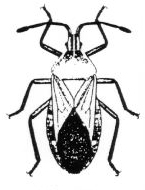 Squash Bugs - May 18, 2005 Jeff Schalau, County Director, Associate Agent, Agriculture & Natural Resources Arizona Cooperative Extension, Yavapai County The squash bug, Anasa tristis, is common throughout the United States. The squash bug will feed on all members of the cucurbit family but are most common on pumpkins and squash. It feeds through piercing/sucking mouthparts. Feeding occurs primarily on the plant foliage, but they will also feed on fruit later in the season. Symptoms of damage include wilting of leaves and ultimately results in leaves that appear black or dried out. Squash bugs are in the order Hemiptera (what entomologists call true bugs). Other true bugs include stink bugs, plant bugs, box elder bugs, bed bugs, and kissing bugs. Insects in this order do not have a larval stage like butterflies, beetles, flies, bees, etc. Immature true bugs are called nymphs and look similar to the adult in shape, but lack wings and are smaller. Adult squash bugs are 5/8 inch long and one third as wide and can fly. They are usually gray to black with the edges of the abdomen having orange and brown stripes. Nymphs are 3/16 to 1/2 in. in length. Young nymphs have a red head and legs with a green abdomen, however as the nymphs age the red color will turn to black. Unmated adults overwinter and find shelter during the early fall under plant debris, around buildings, under rocks, etc; nymphs will die off as temperatures begin to drop. The overwintering adults will emerge in spring and fly into fields when the plants begin to grow. Mating begins in early spring, and the females lay eggs until midsummer. Egg masses are deposited on the underside of leaves, are brownish colored, and usually arranged in rows of 7 to 20. After eggs hatch, they take a total of 4-6 weeks to develop into adults. Nymphs commonly form groups at the base of the plant or under the leaves but are also seen on vines or unripe fruit. They disperse quickly when disturbed. There is typically one generation per year. Both adults and nymphs cause damage by sucking nutrients from leaves and disrupting the flow of water and nutrients, which can cause wilting. Yellow specks will develop on the leaves before wilting is apparent. Damaged leaves eventually turn brown. When squash bug populations are high, small plants can be killed; larger plants can have many damaged leaves and affected vines. Squash bug damage on fruit appears as small lighter colored spots and squash fruits can have a stippled appearance. Squash bugs are a common garden pest and recognizing them is the first step to managing their impact. Maintaining plant health and vigor through proper irrigation and fertilization can help plants to tolerate low levels of squash bug damage. Adult squash bugs are difficult to control, so early detection of nymphs is critical. Monitor young squash plants for egg masses and nymphs. In home gardens, watch for egg masses and the presence of nymphs. Squash bug nymphs and egg masses can be hand picked and destroyed. Another approach is to place boards or shingles on the ground adjacent to plants. At night, squash bugs will cluster there and in the morning they can be gathered and destroyed. Insecticides can be used when squash bug populations are very high and damage threatens the crop. Carbaryl (Sevin) is labeled for squash bugs and has been the traditional insecticide used to control squash bugs in the home garden. Neem insecticides are also labeled for squash bugs, will be most effective in nymphs, and is an “organic” insecticide. Always follow label directions when using pesticides. Naming of companies or products is neither meant to imply endorsement by the author nor criticism of similar companies or products not mentioned. The University of Arizona Cooperative Extension has publications and information on gardening and pest management. If you have other gardening questions, call the Master Gardener line in the Cottonwood office at 646-9113 ext. 14 or E-mail us at mgardener@verdeonline.com and be sure to include your address and phone number. Find past Backyard Gardener columns or submit column ideas at the Backyard Gardener web site: http://cals.arizona.edu/yavapai/anr/hort/byg/. |